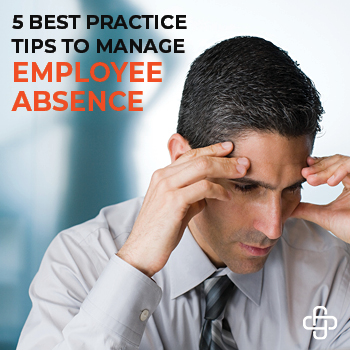 One of the greatest ongoing challenges for employers is effectively monitoring, controlling and reducing absenteeism.
One of the greatest ongoing challenges for employers is effectively monitoring, controlling and reducing absenteeism.
While no one can altogether prevent injury from taking place, you can take measures to minimize the time your employees spend away from work.
How to Lower the Risk
According to the OSHA, 4.1 million U.S. employees experience work-related injuries or illnesses each year and 1.12 million of those employees lose work days as a result. A Return to Work program can be a fantastic tool to minimize the impact injury places on your business. Here’s why:
- It boosts morale.
- It increases productivity.
- It can ensure your employees have a safe return to work (so the risk of a re-injury goes down).
“We’ve found that workers who return to work faster – even in a job that is different than the one they usually do – tend to recover more quickly and more fully than those that stay at home to recover,” says Annette Sanchez, senior vice president of Specialty Risk Services.
“Workers often feel isolated at home and typically the longer they remain out of the workplace, the harder it is for them to return at all. That’s harmful for the employer – who loses a valuable worker – and for the employee, who feels more and more detached from colleagues and friends.”
Studies show that employees who stay out of work with a job-related injury for more than twelve weeks have less than a 50% chance of ever returning.
How Do I Best Manage Absenteeism?
There are 5 ways you can minimize absenteeism in the workplace – and it begins with the manager reinforcing the right protocol.
- Put your safety policy in place. A safety plan should include not just the tools and direction necessary to be safe on the job, but the expectations of every employee, so they remain accountable for every shift. Include who is responsible for specific actions, and what steps each employee is responsible for to achieve a safe workplace.
- Assess the tasks each job requires. A written ‘contract’ is important so each party knows what they are being held accountable for. Having a quick one-on-one (or with each team) can help to improve communication, and bridge the gap of any misunderstandings from the past.
- Identify alternate or modified work. Make a plan for HOW an individual’s job can be modified after injury. What provisions will you make so they can get back to work faster? Put a plan in place. Flexible scheduling can also reduce absenteeism, given the employee’s situation is beyond their control.
- Working with your employee to design their schedule won’t just increase their odds of coming back to work faster – it will allow them to feel cared for by the company.
- Isn’t that a win/win?!
- Report all injuries to the supervisor immediately. A delay in treatment by even one day can increase the risk of an incident having a recordable outcome by 60% – 60%! Encourage – and mandate – all employees to report their injury (minor or major) to their supervisor.
- Take it one step further by initiating a injury case management program. By having the support of a telephonic nurse assessing the injury and monitoring its recovery, you can have a workforce that gets back to work with appropriate measures as early as possible.
- Conduct a Return to Work interview. When it comes to keeping employees safe after they’ve returned to work, communication is key. Use this opportunity to check-in with your employee after they’ve return to the job. Ask them how they feel, and if any additional accommodations need to be made so they stay safe at work while they fully recover.
While there’s no quick fix for employee absenteeism, a preventative plan to keep employees engaged and protocol for returning to work (to get them back to the company as quickly as possible) is key. Follow these five tips to minimize employee absence and witness the difference it makes.










